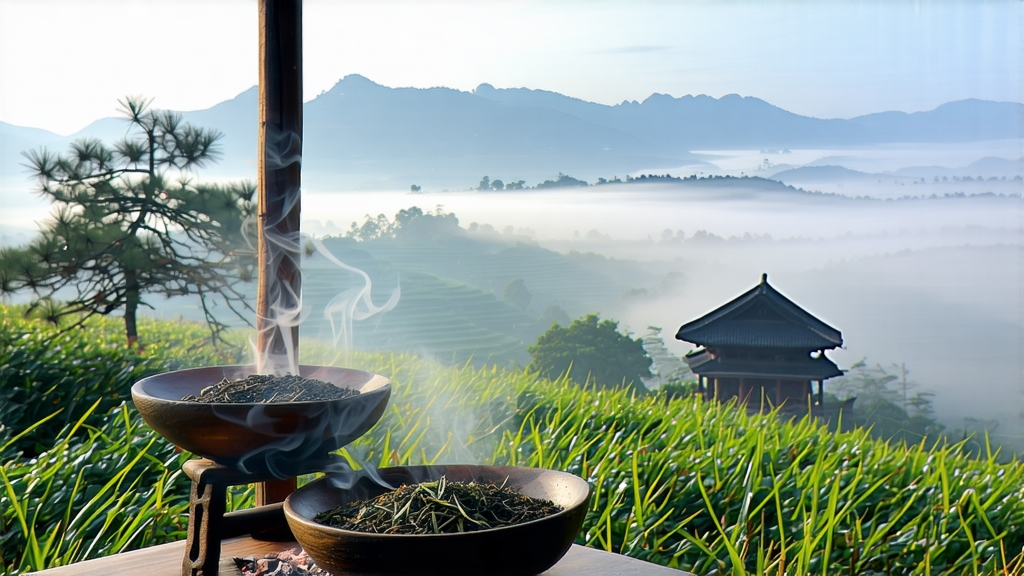
Ask most tea lovers to name a Chinese black tea and they will answer Keemun or perhaps Yunnan Golden Buds. Yet the very first black tea ever created—long before these celebrated varieties—was Lapsang Souchong, a leaf born in the cool, mineral-rich gorges of the Wuyi Mountains in northern Fujian. Its story begins in the late Ming dynasty, around 1604, when passing soldiers commandeered a village tea workshop and delayed the normal green-tea drying schedule. To save the oxidizing leaves from ruin, quick-thinking farmers rushed them over smoldering pine fires. The resulting liquor—brisk, coppery, and laced with the scent of smoked resin—was an instant hit with Dutch traders in Xiamen, who shipped it to Europe as “bohea,” a corruption of “Wuyi.” Within decades, Lapsang Souchong had catalyzed the Western craze for black tea and, indirectly, the Opium Wars and the Boston Tea Party.
Today, two distinct styles coexist under the same name. The export “Russian caravan” version is still withered and dried over roaring pine embers, giving the leaf a glossy black coat and an assertive campfire aroma. The second, increasingly favored by Chinese gourmets, is the unsmoked “Zheng Shan Xiao Zhong,” processed only with gentle charcoal heat that preserves the tea’s natural fruit and honey notes. Both come exclusively from the 600–1,200 m micro-climate of Tongmu Guan, a protected nature reserve where mist, pine, and fir filter the light into a soft, shifting chiaroscuro that shapes the leaf’s chemistry.
Craft begins in mid-April, when only the top two leaves and a bud are plucked from the hardy Xiao Ye Zhong cultivar. After an initial withering on bamboo trays set over natural caves—where temperature and humidity are constant—the leaves are rolled by hand until the cell walls rupture and the sap oxidizes into a deep mahogany. The critical smoking stage follows: fir roots and pine branches are burned below iron mesh screens, never allowed to flame, while workers turn the tea every three minutes for up to eight hours. Master smokers judge timing by the crackle of resin and the rising scent of longan fruit; too little smoke and the tea tastes hollow, too much and it becomes acrid. Finally, the leaf is baked over low charcoal ash to fix the flavor, then rested for one month so the smoke integrates with the intrinsic cocoa and dried-fruit sweetness.
To brew Lapsang Souchong gongfu style, use a small 120 ml porcelain gaiwan or Yixing zini clay pot. Heat the vessel with 95 °C water, then fill one-third with leaf—more than you think you need. Rinse for three seconds and discard; the first proper infusion should last five seconds, increasing by two seconds each subsequent steep. A quality specimen yields eight to ten clear infusions: the opening cup delivers a burst of pine and wintergreen, followed by layers of dark honey, roasted sweet potato, and a lingering note of dried longan. If you prefer Western methods, two grams per 250 ml mug, three minutes at 90 °C, produces a comforting breakfast liquor that marries effortlessly with milk yet still retains its smoky soul.
Pairing food with Lapsang Souchong is an adventure. The smoked version complements anything char-grilled—think cedar-plank salmon or Iberico pork—while its natural tannins cleanse the palate of fatty meats. The unsmoked Zheng Shan style, lighter and orchid-sweet, is exquisite alongside dark-chocolate mousse or a creamy Stilton. In Fujian, locals even drop a pinch into soy-based stews to add depth, a culinary echo of tea’s historic role as both beverage and spice.
To evaluate a sample, first inspect the dry leaf: it should be slender, jet black, and emit a cool pine fragrance rather than a harsh kerosene note. After brewing, the soup must be crystal bright—an amber that the Chinese call “golden circle.” Slurp audibly, letting the liquor aerate across your palate; a top-grade tea will show a three-stage evolution from smoke to fruit to a lingering mineral sweetness known as “yan yun,” the cliff rhyme imparted by Wuyi’s volcanic soil. Finally, check the spent leaves: whole, supple buds reveal careful hand-processing, while excessive crumbs